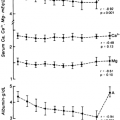DOPAMINE AGONISTS
Part of “CHAPTER 97 – OVULATION INDUCTION“
Hyperprolactinemia causes a decrease in GnRH pulsatility through the direct effect of prolactin on the hypothalamus. Hyperprolactinemia occurs more often in women (1.2%) than in men (0.12%) and is found in 14% to 20% of women with secondary amenorrhea. Eumenorrheic women with hyperprolactinemia usually have infertility problems secondary to corpus luteal dysfunction.
Although surgical and radiologic interventions have been used in patients with prolactin-producing adenomas, medical therapy is more commonly used. Bromocriptine, the most commonly used dopamine agonist, interacts with the dopamine receptors in the brain and anterior pituitary (see Chap. 13 and Chap. 21).54 It is rapidly absorbed orally, with peak serum levels occurring in 2 to 3 hours. If bromocriptine causes nausea and vomiting, vaginal administration, which is equally efficacious and has a longer duration of action, can be used.55 Other side effects include nasal congestion, headache, and fatigue. At least 68% of patients using bromocriptine have one of these side effects.
Stay updated, free articles. Join our Telegram channel

Full access? Get Clinical Tree





